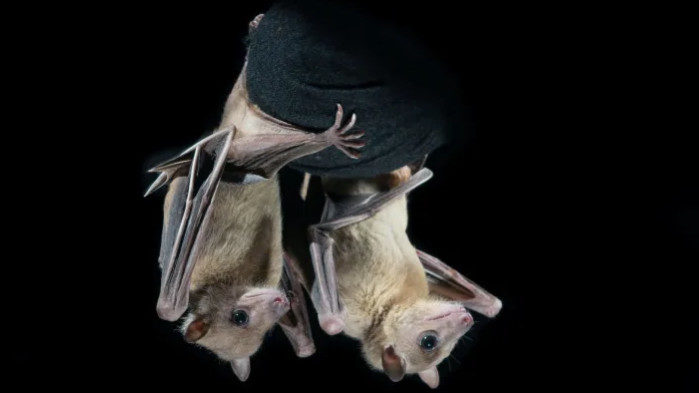
© Itay Belson/Weizmann Institute of ScienceYoung fruit bats NOT the source of coronavirus
A distant relative of the coronavirus afflicting us today was found in a bat in China and that's all it took to demonize the extraordinary flying mammals.
Let's start from the punch line:
Bats did not give us the latest coronavirus. Nor were its notorious cousins SARS-1 or MERS, or even the ebola virus, transmitted from bats to humans. So what did happen?
A distant relative of the current coronavirus, SARS-CoV-2, was isolated in a bat in China. Genetic analyses that looked for similarity between the virus in the bat and
SARS-CoV-2, and factored in the theoretical pace at which the virus mutates, estimated that
the two viruses parted ways between five and 50 years ago. In other words, one possibility is that about five years ago, the bat coronavirus managed to infect some other different animal - we don't know which one at this time. In that next animal, the coronavirus lived and mutated over those five years, and one day infected a human for the first time. There are other hypotheses as well.
Science doesn't yet know where the coronavirus lurked in wait for the past few years, or when it became dangerous to people, or when the first person was infected, nor do we know which animal infected that first human.
The only thing science knows for sure is that the coronavirus isolated from the Chinese bat cannot have infected humans and isn't dangerous to them.
This fact was published two months ago, based on the genetic sequences of the bat and human viruses. This is also true in the cases of SARS, MERS and ebola - despite repeated efforts to locate these viruses in bats, all that researchers found were similar viruses, or evidence of previous exposure that doesn't mean they carried the virus routinely and certainly not that they passed it to humans, despite reports that have appeared in the general press (including in
Haaretz Hebrew edition, on April 19).
Bat Out of HellWhy do bats get such bad press in connection with viruses? In recent years there have been increasingly strident claims that bats carry zoonotic viruses, which can infect humans. But there are serious scientists who disagree with this and argue that
bats are no different than other mammals in the number of zoonotic viruses that they carry, certainly if you consider the large number of species in the bat family. Around a fifth of all the world's mammals are bats.There are several batty characteristics that render them "suspect" when it comes to viruses. Their ability to fly, their presence in all parts of the world, their large colonies and the crowding in which they live; their long lives; and their proximity to humans all make them ostensibly suited to transmitting diseases.
The fact that they are mammals increases the chance of their being transmitters. This is why searching for new viruses in bats has become almost a fad among researchers; and the more in-depth the search, the more likely something will be found.
Moreover, accumulated findings show that
the bat immune system is unique among mammals, and skilled in dealing with viruses. This immune system enables bats to fend off viruses, including deadly ones, by means of
a moderate inflammation response that leads to immunity. As a result, many studies find antibodies in bats - proof that they've been exposed to viruses - without finding the virus itself.Without the live virus itself, the bat cannot be a carrier and certainly can't be a transmitter. This means that the important link in the chain of zoonotic transmission to humans is still missing.
Eating a bat when it is sick could cause infection, just like eating any other sick animal could, and is not recommended. As a general rule, to reduce the chance of zoonotic transmission of viruses from bats or any other animals, it's best to eat them infrequently and in general to minimize encounters with them; to let them live in their natural environments and stop invading their habitats.
It's interesting to note that the amazing bat immune system apparently developed to support its unusual way of life.
Bats live longer than almost any other mammals. In 2006 a Brandt's bat (Myotis brandtii), weighing a mere 7 grams and about the size of your finger, was recaptured after it had been tagged by scientists in Siberia 41 years before! A mouse of similar size wouldn't live for more than two years. Such extreme longevity requires an optimal immune system.
Bats' flying ability, unique among mammals, seems to have also contributed to the development of its immune system. In our studies we've found that small bats weighing no more than 30 grams can fly a distance of more than 250 kilometers in a night.
The energy needs and accelerated metabolism during flight are accompanied by oxidative damage, which requires an appropriate immune system. Some believe this immune system is why bats very rarely develop cancer.In addition, a bat who leaves its cave in the evening raises its body temperature by a few degrees within a minute. This elevated body temperature, which reaches 40 degrees Celsius or more, apparently helps kill undesirable viruses and bacteria.
It's important to stress that our love for bats hasn't blinded us (bats aren't blind either, by the way).
There are zoonotic viruses that are transmitted by bats such as Marburg, Hendra, Nipah and bat rabies, none of which are found in Israel. Bat viruses should be accorded the respect they deserve, but there's no reason to credit bats with viruses that aren't theirs.
Prof. Yovel and Dr. Weinberg teach in the zoology department of Tel Aviv University's life sciences faculty.
Comment: See also: